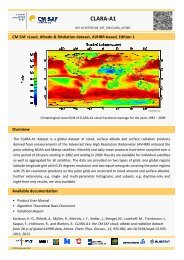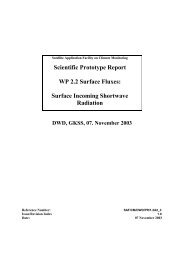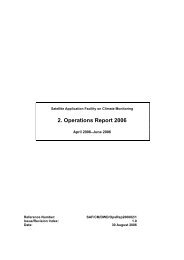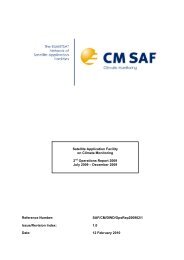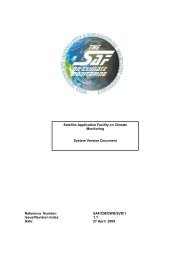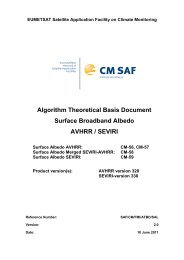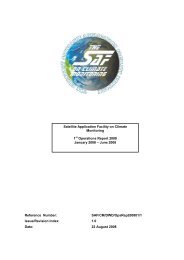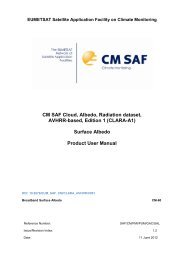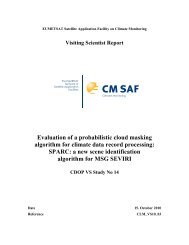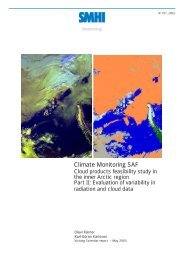Aerosol retrievals from METEOSAT-8 - CM SAF
Aerosol retrievals from METEOSAT-8 - CM SAF
Aerosol retrievals from METEOSAT-8 - CM SAF
You also want an ePaper? Increase the reach of your titles
YUMPU automatically turns print PDFs into web optimized ePapers that Google loves.
<strong>SAF</strong> on Climate Monitoring Visiting Scientists Report Doc. No: 1.0<br />
Issue : 1.0<br />
Date : 4 October 2006<br />
6 MSG/SEVIRI methodology<br />
6.1.1 Introduction<br />
This chapter presents the preliminary results of MSG/SEVIRI <strong>retrievals</strong> of aerosol properties over<br />
land. We decided to demonstrate the potential MSG/SEVIRI for aerosol <strong>retrievals</strong> by developing a<br />
simple algorithm to retrieve the AOT <strong>from</strong> SEVIRI. We focused on the aerosol optical thickness<br />
(AOT), which is a key parameter for measuring the aerosol loading in the atmosphere. Most of the<br />
assumptions used in the algorithm were made to support the development of an aerosol product<br />
<strong>from</strong> MSG/SEVIRI in a short time. From this prototype, a robust algorithm can easily be obtained<br />
after implementation of radiative transfer calculations.<br />
In short, the AOT is retrieved <strong>from</strong> the reflectances at one wavelength (i.e. 670nm) in two steps,<br />
using a method similar to the one Knapp et al. (2005) developed for GOES-8. The first step is the<br />
creation of a 3D images data set (for a period of 15 days), <strong>from</strong> which we built a mosaic<br />
(reflectance surface maps of reference) where the darkest pixel of the time period is chosen as the<br />
“clear sky” condition. In the second step these surface reflectance map are used to retrieve AOT for<br />
each images.<br />
6.1.2 Method description<br />
The method is based on the unique capabilities of the MSG/SEVIRI measurements. We take<br />
advantage the high temporal resolution (15 minutes) and fixed viewing geometry of SEVIRI. We<br />
can reasonably assume that for given acquisition time (i.e. 8/00 UTC) within a period of 15 days:<br />
• The solar zenith angle and the relative azimuth angle do not vary significantly. So for one pixel,<br />
the viewing geometry is stable. For example, at 12:00 UTC and over the fifteen first day of July<br />
2005, the solar zenith angle varies of a value between 0.5° and 1.6° depending on the Earth's<br />
locations. The variation in azimuth angle is between -1.2 and 4.5°.<br />
• The surface properties do not change (except for particular and exceptional cases such as floods,<br />
fires and snowfall).<br />
Measurements that are made every day for the same pixel at the same time can then be easily<br />
compared. After screening the clouds and assuming no change in surface reflectivity, the<br />
differences in the measurements come <strong>from</strong> differences in the state of the atmosphere or changes in<br />
aerosols properties. In a first step we will explain how we get ride of the surface by monitoring the<br />
- 17 -



